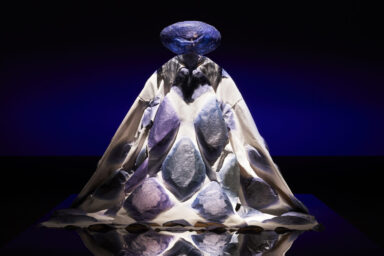Text by: Domenico Costantini
The personalisation of matter as an element of dialogue between two artists: Gaetano Pesce and Iris Van Herpen
Silicone appears to us in the visual arts. From Gaetano Pesce, the Italian sculptor, designer and architect, to the fashion designers of the new generation such as Iris van Herpen, the Flemish sculptor.
Silicone is a material that does not completely lose its fluidity. Leaning against light sources as in lamps or while to containing water as in vases, or in the movement of clothes and accessories, it sublimates the idea of the uncontrollable and the language of creaminess.
The structure of silicone is that of a plastic polymer therefore synthetic, hardenable and mouldable at will; the difference with classic ‘plastics’ comes from the silicon spiral (from which it takes its name) rather than the carbon spiral, so it is not made from petroleum. Recyclability is a strong point.
The analysis of the relationship between the different applications made by Gaetano Pesce and Iris Van Herpen focuses on two concepts: static and deformable.
Clothing must necessarily provide elasticity and movement because it is born as an offshoot of a body that must move in order to live. The design object is different, as it inhabits a space so it does not stand on another structure and can do so with its decorative and at the same time self-supporting staticity. The dress moulds itself onto the body, the object moulds a space.
In Iris Van Herpen the “space” takes on the connotations of a body, a body in movement. With Pesce, space remains as such. Although they deal with the same material, the end result is completely different. Combination is another factor that unites the two artists: the desire to eliminate the boundaries between disciplines and create a personal hybrid poetics that is always in flux. Iris Van Herpen blends art, science and architecture with traditional methods of making clothes. Her multidisciplinary approach to creation represents a radical and contemporary vision, as in Gaetano Pesce where opposites and contradictions coexist beautifully in extremely material objects of all kinds, in which the manual and physical nature of the workmanship is evident but so is a conceptuality verging on the metaphysical. Finally, the leitmotif that reconciles and concludes this hypothetical encounter between the two artists is the search for variation, for the “unique piece”, or rather the “customization” within mass industrial production, as Iris Van Herpen does in her atelier in Amsterdam, creating only on demand, producing only ordered garments.



